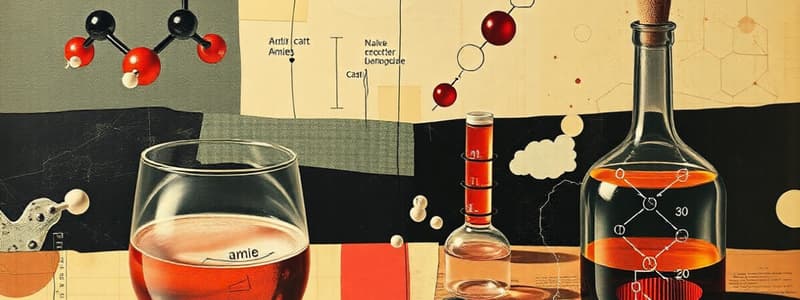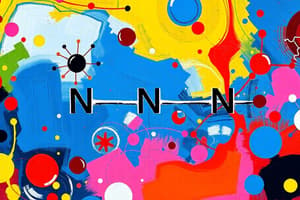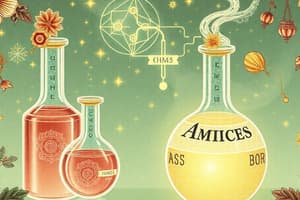Podcast
Questions and Answers
A student was asked to convert nitrobenzene to benzene. Teacher suggested that he should first treat nitrobenzene with Sn and HCl and then proceed with the product obtained to get benzene. Write down the reaction involved in the above process.
A student was asked to convert nitrobenzene to benzene. Teacher suggested that he should first treat nitrobenzene with Sn and HCl and then proceed with the product obtained to get benzene. Write down the reaction involved in the above process.
NO₂
Sn+HCl
NH₂
N2+CI
NaNO2 & HCl 0-5°C
H3PO2 (aq)
What are the products obtained when aniline is treated with bromine water?
What are the products obtained when aniline is treated with bromine water?
- nitrobenzene
- chlorobenzene
- phenol
- 2,4,6-Tribromoaniline (correct)
How will you convert nitrobenzene to aniline?
How will you convert nitrobenzene to aniline?
NO 2 Sn+HCl or Fe+HCl NH₂
Write down the isocyanide test for the primary amines.
Write down the isocyanide test for the primary amines.
Why did the student obtain only m-nitroaniline instead of p-nitroaniline when nitrating aniline in a strongly acidic medium?
Why did the student obtain only m-nitroaniline instead of p-nitroaniline when nitrating aniline in a strongly acidic medium?
Explain how the student should proceed to get p-nitroaniline from aniline.
Explain how the student should proceed to get p-nitroaniline from aniline.
How can you convert benzyl amine to benzoic acid?
How can you convert benzyl amine to benzoic acid?
How can you convert benzoic acid to benzamide?
How can you convert benzoic acid to benzamide?
How is aniline converted to benzenediazonium chloride?
How is aniline converted to benzenediazonium chloride?
How is chlorobenzene obtained from benzenediazonium chloride?
How is chlorobenzene obtained from benzenediazonium chloride?
How is phenol obtained from benzenediazonium chloride?
How is phenol obtained from benzenediazonium chloride?
What is Hinsberg's reagent?
What is Hinsberg's reagent?
How will you distinguish primary, secondary and tertiary amines using Hinsberg's reagent?
How will you distinguish primary, secondary and tertiary amines using Hinsberg's reagent?
Write the carbyl amine reaction.
Write the carbyl amine reaction.
How will you convert aniline to phenol?
How will you convert aniline to phenol?
How can you convert an amide into an amine with one carbon atom less than that of the amide?
How can you convert an amide into an amine with one carbon atom less than that of the amide?
How can you convert an amide into an amine containing the same number of carbon atoms as that in the amide?
How can you convert an amide into an amine containing the same number of carbon atoms as that in the amide?
Arrange the following compounds in the increasing order of their basic strength.
NH3, C6H5NH2, CH3 - NH2, (CH3)2NH, (CH3)3N.
Arrange the following compounds in the increasing order of their basic strength. NH3, C6H5NH2, CH3 - NH2, (CH3)2NH, (CH3)3N.
How will you convert aniline (C6H5 NH2) to chlorobenzene?
How will you convert aniline (C6H5 NH2) to chlorobenzene?
Arrange the following amines in increasing order of their basic strength.
C6H5NH2, C2H5NH2, (C2H5)2NH, NH3.
Arrange the following amines in increasing order of their basic strength. C6H5NH2, C2H5NH2, (C2H5)2NH, NH3.
Represent a reaction to explain the basic character of aniline.
Represent a reaction to explain the basic character of aniline.
Name the reagents used in the Hoffmann bromamide reaction.
Name the reagents used in the Hoffmann bromamide reaction.
What is the significance of the Hoffmann bromamide reaction?
What is the significance of the Hoffmann bromamide reaction?
Give one chemical test to distinguish between methyl amine and dimethyl amine. Write down the chemical reaction.
Give one chemical test to distinguish between methyl amine and dimethyl amine. Write down the chemical reaction.
Write a method of preparation of primary amines.
Write a method of preparation of primary amines.
Describe a chemical reaction given only by primary amines.
Describe a chemical reaction given only by primary amines.
What is diazotization?
What is diazotization?
Arrange the following amines in the increasing order of base strength.
CH3 NH2, (CH3)2NH, (CH3)3N, C6H5NH2.
Arrange the following amines in the increasing order of base strength. CH3 NH2, (CH3)2NH, (CH3)3N, C6H5NH2.
Suggest the main product of the reaction:
CH3NH2 + CHCl3 + alc. КОН
Suggest the main product of the reaction: CH3NH2 + CHCl3 + alc. КОН
Suggest the main product of the reaction:
CH3CONH2 + Br2 + NaOH
Suggest the main product of the reaction: CH3CONH2 + Br2 + NaOH
Write the IUPAC name of the following compound: H2N-(CH2)6-NH2
Write the IUPAC name of the following compound: H2N-(CH2)6-NH2
Which is a stronger base: CH3-NH2 or C6H5-NH2? Why?
Which is a stronger base: CH3-NH2 or C6H5-NH2? Why?
Arrange the following compounds in the increasing order of their basic strength: CH3-NH2, (CH3)2NH, NH3, C6H5-NH2
Arrange the following compounds in the increasing order of their basic strength: CH3-NH2, (CH3)2NH, NH3, C6H5-NH2
How will you carry out the Hoffmann bromamide reaction?
How will you carry out the Hoffmann bromamide reaction?
How will you carry out the carbyl amine reaction?
How will you carry out the carbyl amine reaction?
Represent the structure of secondary and tertiary amine
Represent the structure of secondary and tertiary amine
Why does aniline not undergo Friedel-Crafts reaction?
Why does aniline not undergo Friedel-Crafts reaction?
Arrange the following compounds in the increasing order of their basic strength.
NH3, C2H5NH2, C6H5NH2, (C2H5)2NH
Arrange the following compounds in the increasing order of their basic strength. NH3, C2H5NH2, C6H5NH2, (C2H5)2NH
Identify the products B and C write their formulae.
Identify the products B and C write their formulae.
The most basic compound among the following is:
i) C2H5NH2 ii) C6H5NH2 iii) NH3 iv) (C2H5)2NH
The most basic compound among the following is: i) C2H5NH2 ii) C6H5NH2 iii) NH3 iv) (C2H5)2NH
Compound A is treated with Ethanolic NaCN to give the compound C2H5CN (B). Compound B on reduction gives compound C. Identify compounds A and C.
Compound A is treated with Ethanolic NaCN to give the compound C2H5CN (B). Compound B on reduction gives compound C. Identify compounds A and C.
Name the test used to identify primary amines using CHCl3 and ethanolic KOH.
Name the test used to identify primary amines using CHCl3 and ethanolic KOH.
How can it convert methyl iodide to ethanamine?
How can it convert methyl iodide to ethanamine?
Gabriel synthesis is used for the preparation of which type of amines?
Primary ii) Secondary iii) Tertiary iv) Quaternary
Gabriel synthesis is used for the preparation of which type of amines? Primary ii) Secondary iii) Tertiary iv) Quaternary
Complete the following equations:
(a) R-NH2 + CHCl3 + 3 KOH
(b) NH2
Con: H2SO4
→?
Complete the following equations: (a) R-NH2 + CHCl3 + 3 KOH (b) NH2 Con: H2SO4 →?
The reaction in which an amide is converted into a primary amine by the action of Br2 and alcoholic NaOH is known as...
The reaction in which an amide is converted into a primary amine by the action of Br2 and alcoholic NaOH is known as...
How is a primary amine distinguished from a secondary amine using a chemical test?
How is a primary amine distinguished from a secondary amine using a chemical test?
Explain the reaction of primary, secondary and tertiary amines with Hinsberg's reagent.
Explain the reaction of primary, secondary and tertiary amines with Hinsberg's reagent.
Complete the following table:
Complete the following table:
Arrange the following amines in the increasing order of basic strength:
CH3NH2, C6H5NH2, (CH3)3N, (CH3)2NH
Arrange the following amines in the increasing order of basic strength: CH3NH2, C6H5NH2, (CH3)3N, (CH3)2NH
Benzene sulphonyl chloride and aqueous NaOH can be used to distinguish three classes of amines such as primary, secondary and tertiary.
(i) Name the above test.
(ii) How will you distinguish between methyl amine and dimethyl amine using this test?
Benzene sulphonyl chloride and aqueous NaOH can be used to distinguish three classes of amines such as primary, secondary and tertiary. (i) Name the above test. (ii) How will you distinguish between methyl amine and dimethyl amine using this test?
Which of the following amine cannot be prepared by Gabriel Phthalimide synthesis?
Which of the following amine cannot be prepared by Gabriel Phthalimide synthesis?
Explain the method to distinguish primary, secondary and tertiary amines. Also write the chemical equations involved.
Explain the method to distinguish primary, secondary and tertiary amines. Also write the chemical equations involved.
Identify A, B, C and D in the following reactions:
(i) Br2
A
NaOH
NH2
(ii) CH3-CH2-NH2 + CHCl3 + 3KOH
(iii) NH2
Bromine Water
C
(iv) N₂+ CF.
D + KCl + N2
Heat
Identify A, B, C and D in the following reactions: (i) Br2 A NaOH NH2 (ii) CH3-CH2-NH2 + CHCl3 + 3KOH (iii) NH2 Bromine Water C (iv) N₂+ CF. D + KCl + N2 Heat
A white precipitate is obtained when aniline reacts with bromine water at room temperature. The chemical name of the precipitate is...
A white precipitate is obtained when aniline reacts with bromine water at room temperature. The chemical name of the precipitate is...
Flashcards
Conversion of Nitrobenzene
Conversion of Nitrobenzene
Nitrobenzene is converted to benzene via reduction using Sn and HCl.
Bromine Water Reaction
Bromine Water Reaction
Aniline treated with bromine water yields 2,4,6-Tribromoaniline.
Isocyanide Test
Isocyanide Test
Primary amines react with chloroform and KOH to form isocyanides.
Nitration of Aniline
Nitration of Aniline
Signup and view all the flashcards
P-Nitroaniline Preparation
P-Nitroaniline Preparation
Signup and view all the flashcards
Distinguishing Amines
Distinguishing Amines
Signup and view all the flashcards
Hofmann Bromamide Degradation
Hofmann Bromamide Degradation
Signup and view all the flashcards
Carbyl Amine Reaction
Carbyl Amine Reaction
Signup and view all the flashcards
Basic Strength of Amines
Basic Strength of Amines
Signup and view all the flashcards
Diazotization
Diazotization
Signup and view all the flashcards
Order of Basic Strength - Amine Types
Order of Basic Strength - Amine Types
Signup and view all the flashcards
Reducing Nitrobenzene
Reducing Nitrobenzene
Signup and view all the flashcards
Distinguishing Methyl and Dimethyl Amine
Distinguishing Methyl and Dimethyl Amine
Signup and view all the flashcards
Reagents in Hoffmann Reaction
Reagents in Hoffmann Reaction
Signup and view all the flashcards
Ethanolic KCN Conversion
Ethanolic KCN Conversion
Signup and view all the flashcards
Friedel-Crafts Limitation
Friedel-Crafts Limitation
Signup and view all the flashcards
2,4,6-Tribromoaniline
2,4,6-Tribromoaniline
Signup and view all the flashcards
Primary Amines
Primary Amines
Signup and view all the flashcards
Secondary Amines
Secondary Amines
Signup and view all the flashcards
Tertiary Amines
Tertiary Amines
Signup and view all the flashcards
Using Hinsberg's Test
Using Hinsberg's Test
Signup and view all the flashcards
Reducing Benzamide
Reducing Benzamide
Signup and view all the flashcards
Conjugation Effect
Conjugation Effect
Signup and view all the flashcards
Gabriel Synthesis
Gabriel Synthesis
Signup and view all the flashcards
Effects of KOH
Effects of KOH
Signup and view all the flashcards
Study Notes
HSE Previous Questions and Answers (Amines)
-
Question 1 (March 2009): Convert nitrobenzene to benzene. The reaction involves treating nitrobenzene with Sn and HCl, followed by processing the resulting product. The reaction is detailed in the answer.
-
Question 2 (March 2010):
-
Part a: Aniline treated with bromine water forms 2,4,6-Tribromoaniline.
-
Part b: Nitrobenzene is converted to aniline using Sn and HCl, or Fe and HCl.
-
Part c: The isocyanide test (or carbyl amine reaction) for primary amines involves heating with chloroform and alcoholic potassium hydroxide. This forms foul-smelling isocyanides or carbylamines.
-
Question 3 (March 2011):
-
Part a: A student attempting to prepare p-nitroaniline by nitrating aniline with concentrated nitric and sulfuric acid, mistakenly gets m-nitroaniline due to the meta-directing nature of the anilinium ion formed in the strongly acidic reaction medium.
-
Part b: The correct method for preparing p-nitroaniline from aniline involves first deactivating the NH2 group by acetylation to form acetanilide. This is then nitrated using a nitrating mixture, followed by hydrolysis.
-
Question 4 (March 2011): Amines are a versatile functional group useful in the preparation of various organic compounds. Transformations are mentioned with steps involved
-
Question 5 (SAY 2011):
-
Part a: Aniline is converted to benzenediazonium chloride by treating with NaNO2 and HCl (or, with nitrous acid [HNO2]).
-
Part b:
-
Chlorobenzene is obtained by treating benzenediazonium chloride with HCl in the presence of cuprous chloride or copper powder.
-
Phenol forms from benzenediazonium chloride by heating with water.
-
Question 6 (March 2012):
-
Part i: Hinsberg's reagent is benzenesulfonyl chloride (C6H5SO2Cl).
-
Part ii: Primary amines react with the reagent, forming a precipitate of N-alkylbenzenesulfonamide that is soluble in alkali. Secondary amines give a precipitate that is insoluble in alkali, and tertiary amines do not react.
-
Question 7 (SAY 2012):
-
Part a (i): Carbyl amine reaction (or isocyanide reaction) involves reacting a primary amine with chloroform and alcoholic potassium hydroxide to produce foul-smelling isocyanides.
-
Part a (ii): Converting aniline to phenol is covered elsewhere in the notes.
-
Part b (i) and (ii): Methods for converting amides into amines with fewer or equal carbon atoms are explained elsewhere in the notes.
-
Question 8 (March 2013):
-
Part a: The increasing order of basic strength is C6H5NH2 < NH3 < CH3NH2 < (CH3)2NH < (CH3)3N.
-
Part b: The conversion process of aniline (C6H5NH2) to chlorobenzene is found elsewhere in the notes.
-
Question 9 (SAY 2013):
-
Part a: The increasing order of basic strength is C6H5NH2 < NH3 < C2H5NH2 < (C2H5)2NH
-
Part b, c, d, e: Further reactions involving amines are detailed elsewhere.
-
Question 10 (March 2014):
-
Part a: Hoffman bromamide degradation reaction is a method to prepare primary amines.
-
Part b: The carbyl amine reaction is a reaction unique to primary amines.
-
Part c: Diazotization is an organic reaction used to convert aniline to benzenediazonium chloride using NaNO2 and HCl (or, with nitrous acid[HNO2]) to form benzene diazonium chloride in the reaction.
-
(Questions 11-44) continued in subsequent notes...
Studying That Suits You
Use AI to generate personalized quizzes and flashcards to suit your learning preferences.




